-
Posts
19,756 -
Joined
Content Type
Forums
Detector Prospector Home
Detector Database
Downloads
Posts posted by Steve Herschbach
-
-
I wrote an article on the subject in March 2013 for the ICMJ Prospecting & Mining Journal at http://www.icmj.com/article.php?id=2349
Gold is not income until sold. Once sold for money, you have income to deal with for tax purposes. You can run as a regular business with profits and losses, or as a hobby, which allows you to offset income with expenses up to the point where you might show a loss. A hobby business is not allowed to show losses, only profits.
My prospecting is a for profit enterprise, one that has made me a surprising amount of money over the years. As such I run it as a business. I have a business license and file a schedule C yearly. Been a going concern under a couple different names for over 30 years now.
The key is to be serious about running things in a businesslike fashion. I have a business checking account and keep my business spending separate from my personal spending.
If you are someone who is actually finding any quantity of gold it is something well worth learning about.
Business or Hobby? http://www.irs.gov/uac/Business-or-Hobby%3F-Answer-Has-Implications-for-Deductions
Hobby Deductions. http://www.irs.gov/uac/Is-Your-Hobby-a-For-Profit-Endeavor%3F
Placer Mining Business http://www.irs.gov/pub/irs-mssp/placer.pdf
Now that I have retired from my regular day job my prospecting business is now my primary source of income so I am being more serious than ever about keeping a good set of books.
When in doubt do consult with a tax expert, which I am not. I used to do my own taxes but things got so complicated the last ten years I just got a good tax guy to keep me out of trouble. Well worth the money, and it is tax deductible! -
You will find computer files offer the benefit of being searchable, and you can pack an entire library into the field on a tablet device or even a phone.
-
You have to love the internet. This book was a rare gem only to be found in libraries or used book stores. Now you can download this classic for free. Anyone with an interest in California gold should download this invaluable reference and study it.
The Tertiary Gravels of the Sierra Nevada of California, 1911, by Waldemar Lindgren
USGS Professional Paper 73You can find this and many more useful free books on this website at the Metal Detecting & Prospecting Library
-
Hi Greg,
Thanks for visiting and posting that. I think that is just an awesome find. I have found quite a few half dollars but only one dollar coin in all my years of detecting. They have been harder to find than one ounce gold nuggets for me! A beach is the spot however, and punching deep like you did is the way to find that old stuff everyone else has passed over. I have had good luck with old coins at beaches with PI detectors. Anyway, good on you making that find! You have to be patient with the ATX but if you are it will reward you with rare finds like that.
-
I will be surprised to see any response on that Keith. I doubt many nugget hunters have even heard of the 10.7 kHz Outlaw, let alone used one. Good detector though, should work at least as well as a hundred other detectors. In theory any good detector can find gold. The Outlaw would probably do just fine in tailing piles chasing larger gold. But you know all that already!
I would be inclined more towards the higher frequency Vaquero myself. I used it once at Ganes Creek, worked just fine. I did find a nugget with it but most of the trip my F75 SE was getting the use. My buddy George also toted a Tejon to Ganes Creek, also seemed to work fine. In lower mineral ground with lots of ferrous stuff lots of decent coin detectors can work fine. The Vaquero and Tejon at running at the higher 14 kHz though making them a tad hotter on gold.
-
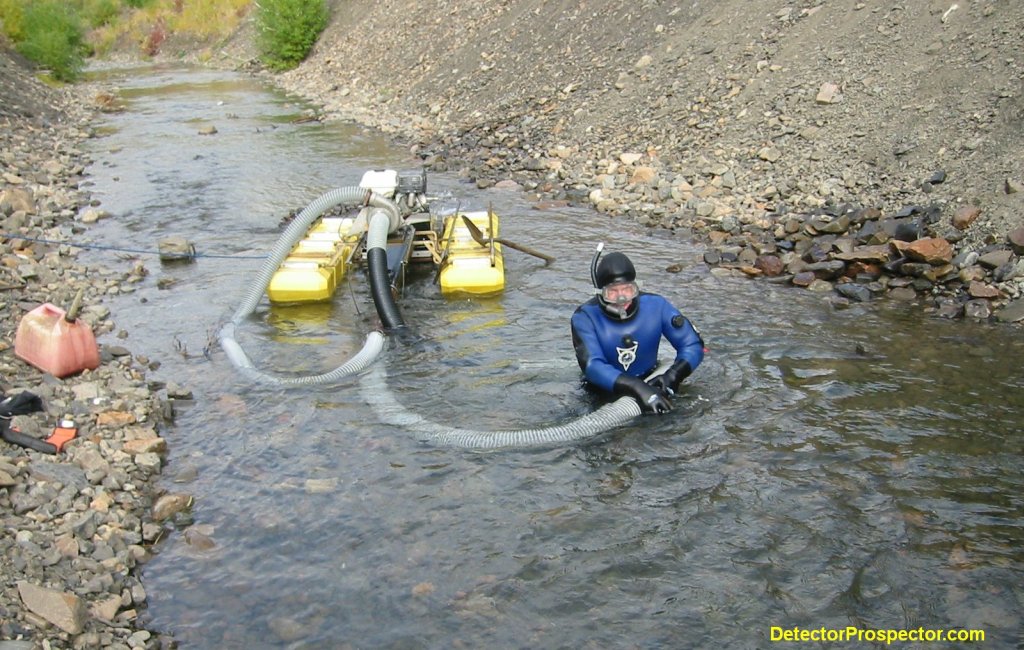
I visited Ganes Creek, Alaska many times over the years. This was always to metal detect for gold in my case. However, there were others who wanted to suction dredge while at Ganes Creek. My friend Brian Berkhahn was one of them. Brian just loves dredging. Detecting he is good at but has less patience for. So in 2002 while we were at Ganes on a nugget hunt Brian talked Doug into letting him use a 5" Keene dredge they had at the mine. There was a drainage ditch upstream where several large nuggets had been found in the pile of material dug out of the ditch. I was a bit skeptical as the nuggets in the tailings are few and far between, but Brian wanted to give it a go. As I recall he did not find much here, but he does have the distinction of being one of the few guys who have done some dredging at Ganes Creek. He is on the forum so maybe he will chime in with his recollections on this photo.
-
The MX5 weighs 3.9 lbs and the MXT 4.3 lbs. The MX5 is locked in full time ground tracking and you lose the full range discriminate knob instead having 20 notch discriminate settings. This makes it very hard if not impossible to fine tune the spot where ferrous targets are rejected and non-ferrous (gold) accepted. Just my opinion but the loss in capability as a nugget detector would not be worth the small weight savings. Stick with what you know best and works well until something dramatically better floats your boat.
It is interesting that nugget engineer guru Dave Johnson has said he is not fond of automatic ground tracking and has avoided offering it on new Fisher products. And at the same time White's has produced two models recently, the MX5 and Sierra Gold Trac, that can only be operated in full time ground track mode. I rarely use ground tracking myself, but I do like having it there in case I need it, as long as it can be shut off.
I was at a Minelab conference where the engineers highly recommended the X-Terra 705 be left in ground tracking mode. Their contention was that most detector owners do not know how to properly ground balance a detector, and more importantly, keep it properly ground balanced. They may get it right at first, but then the ground changes when the operator is not paying attention, and now the unit is not in proper tune. Therefore in their opinion most people were better off in track mode. When teaching newbies, I usually tell them to run in tracking until they learn the business, as it removes a possibility for error. So the case can certainly be made that running in tracking is better than using manual but not being on top of it. White's is probably just aiming to keep the detectors easy to run and less able to be affected by operator error.
-
The larger of the two is a perfect pendant nugget. And the other one really interesting. Good going Ray!
-
ATX, TDI, GPX. What is it with detector companies and three letter acronyms? I liked it more when they were called Coinmaster or Goldmaster. At least that gave you a clue about what the detector was supposed to do.
The three detectors representing the state of the art in ground balancing pulse induction (GBPI) metal detectors. The Garrett ATX, White's TDI, and Minelab GPX 5000. You rarely see them all pictured together so I thought I would post one.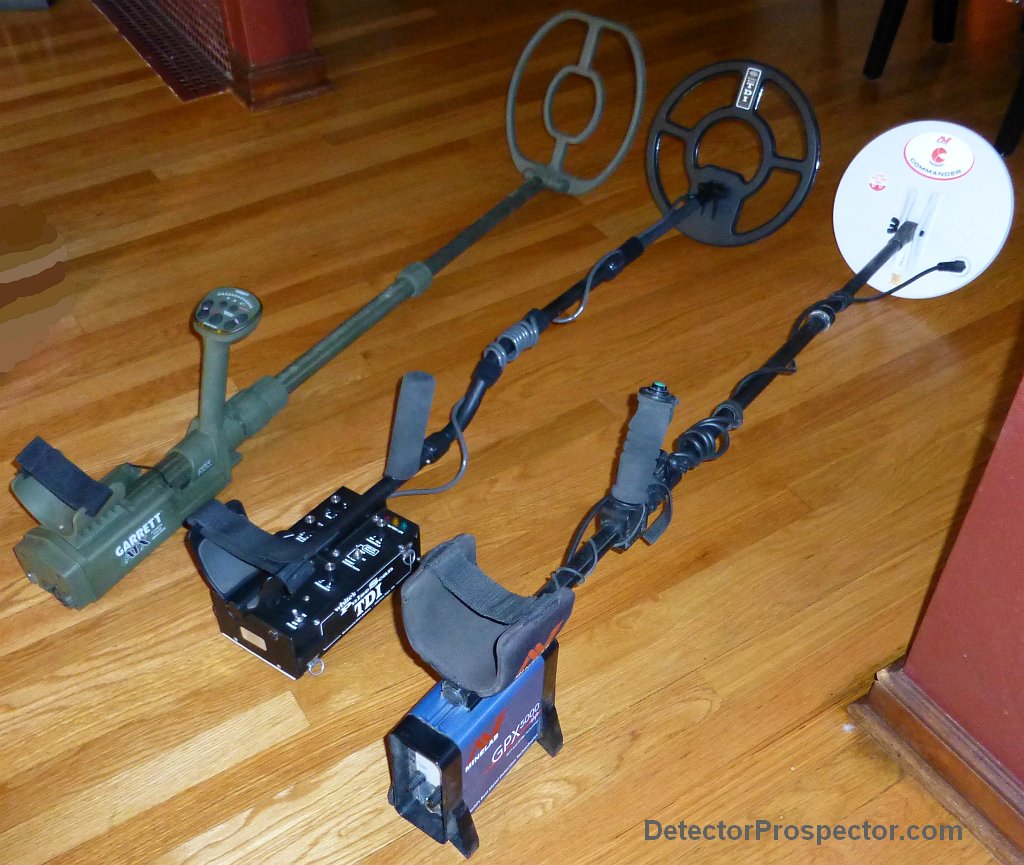
Garrett ATX, White's TDI, Minelab GPX 5000These three detectors are all very good at what they are basically made for, which is dealing with ground mineralization and hot rocks that make using VLF detectors very difficult. In particular VLF performance is severely impeded in extremely mineralized ground. In low mineral ground a good VLF prospecting detector running in all metal mode can deliver results rivaling PI detectors with the added benefit of having good discrimination options. Anybody doing much prospecting, however, will eventually run into locations where ground mineralization and hot rocks makes using a VLF such a challenge that a good ground balancing pulse induction detector is the only real option.
The GPX 5000 represents the current state of the art, and is the easy option if money is no object. It is well designed for long hours of prospecting, has an incredible variety of optional coils, and can handle most any ground conditions with many tuning options.
The Garrett ATX provides performance that comes close to the GPX at a much lower price, with the added benefit of being waterproof to ten feet. Actually, this is only a benefit if you need it. Otherwise it makes the detector heavier than need be and limits the available coil options. Still, if the GPX is not an option the ATX would be my next choice in a new detector with a warranty. For those needed waterproof it is the only real option along with its predecessor, the Garrett Infinium.
The White's TDI is an older design but still very capable. It costs less than the other two options, and unlike the Garrett it has light weight versions and models that can be hip or chest mounted. It is a good option to explore for those on a budget or needing the most ergonomic solution. The TDI is also a very respected beach detector, like the ATX above, but it has no waterproof option.
-
The Garrett ATX and the Minelab CTX 3030. Are they an odd couple, or a perfect couple? Here is a side by side photo for your consideration.
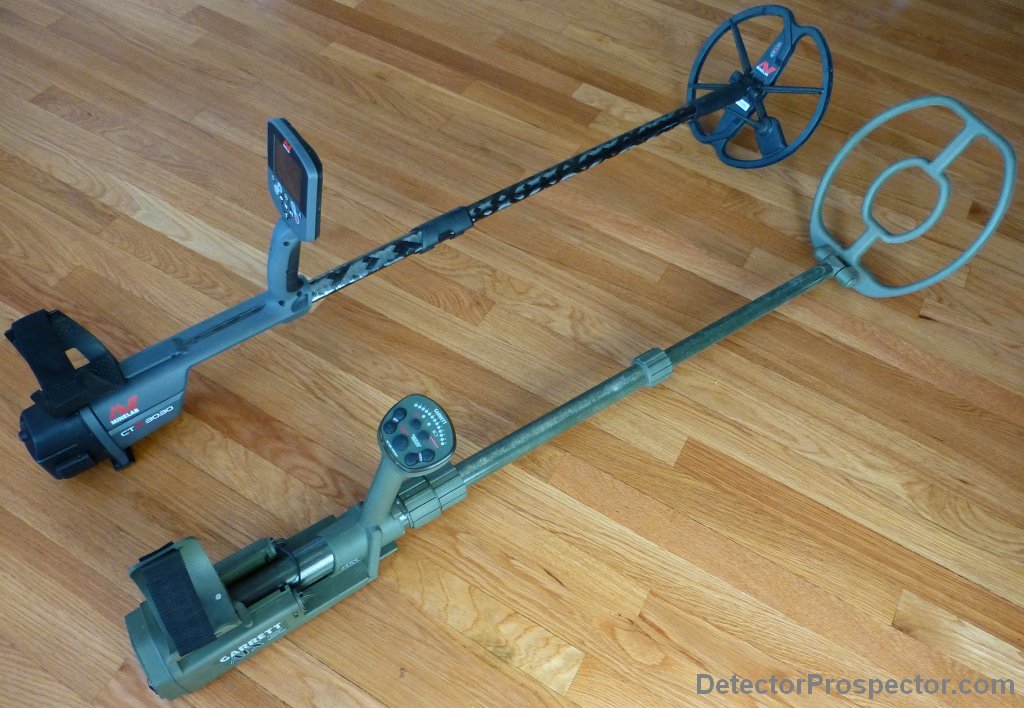
Minelab CTX 3030 and Garrett ATXThe Garrett ATX and Minelab CTX 3030 share a certain similarity of design with coil cables hid inside the lower rod assembly and controls on the end of the handle. Both are waterproof to 10 feet. Yet they are also exact opposites in that the CTX is one of the best discriminating VLF detectors you can buy, whereas the ATX is a dig it all PI detector designed for maximum depth in very difficult ground. They actually do make a really good pairing as they complement each other very well.
I am an avid prospector and also a very avid jewelry hunter who needs to be able to hunt in the water. It would be a very hard thing for me to do, but if I had to narrow it all the way down to only two metal detectors, you are probably looking at the two I would choose. I would be making quite a few compromises but the bottom line is I can do just about anything I need to do with these two detectors together, and do it quite well.
As it is when looking at the two it really boils down to whether you need good discrimination or not. The CTX has it, the ATX does not.
-
The only way the White's bolt would work on my Minelab coils is if I drilled the ears out.
-
No, the White's lower end is narrower and bolt size much larger. It is easier to use a Minelab lower rod, but they are pretty expensive. The rod diameter is the same so they both fit the same in the upper rod assembly. The little locking tabs for White's are on each side of the rod, and Minelab uses one on the bottom of the rod, but you can just ignore them and use the twist lock system.
-
For those of us interested in large gold a US nickel makes a good standardized test item. It reads more or less the same as a 1/4 oz gold nugget though of course nuggets vary considerably. The advantage to a nickle is anyone can obtain one and they all read the same.
-
I was really heavy into very late fall and very early spring dredging in the late 90's time frame. This photo is from 1996 and was taken by my friend Rich Lampright. I worked a lot at Crow Creek Mine, which is glacial fed. It runs very high and fast in the summer when the glacier is melting. The best time to dredge is in the winter months when freezing temps bring the water levels down by over 50% and the water starts running crystal clear. It also made for some very cold dredging at times, but properly outfitted with a good drysuit you can stay surprisingly comfortable. Usually.
Funny how some days I really was cozy and others it was just plain cold. I could operate well down to about 15 degrees. Below that, and the water literally froze in the sluice box while it was running. I resorted to subsurface dredges for the coldest spells as the box being underwater did not freeze up. But even then you see weird stuff. Ice crystals floating in the water build like snow drifts of slush behind rocks on the bottom, and giant balls of slush form on the pump intakes, eventually plugging them. Why suffer this you ask? I was seeing multi-ounce days working by myself. I took a lot of gold out of Crow Creek; even after paying a percentage to the owners it was good. In fact the best dredging I ever did. My best day in there working a 6" by myself was over 8 ounces of gold.
This was my favorite dredge, my old Keene 6" with twin Honda 6HP pumps. This model was made with a molded marlex powerjet in two pieces - the jet and the flare. The jet and flare assembled was about six feet long but I could just toss it over my shoulder and carry it in one piece it was so light. The dredge had a stout frame with a lever handle leveling system, far superior to the later slide the box back and forth nonsense. The box was a well built single run sluice that I preferred over later double-decker designs. I never should have sold it. I did however, to Brian Berkhahn, and he also got a lot of gold with it. And I know he now also regrets selling it. It was the best Keene dredge I ever owned.
Mark Keene told me they stopped making the marlex jets due to a high failure rate with the process but they should have either fixed the process or just charged more to make up for the failures. It was an incredible advance in the technology, and amazingly after all the years of use the inside of that jet never showed more than light scuffing. I think it was actually more durable than steel jets.This photo is first thing in the morning, breaking away all the ice that has formed around the dredge overnight.
-

My first gold dredge! After seeing a guy running a suction dredge at Crow Creek Mine south of Anchorage, Alaska I ordered my first dredge in early 1973. I had never seen a dredge before, and this guy was wearing a wetsuit running a 4" dredge about chest deep in the water. He saw my interest and shut the dredge down, pointed at the first riffle, and there was more chunky gold than I had ever found. I was hooked!I got the dredge direct from Keene, only way I could get one back then. Knowing nothing about dredges I saw no reason why I should spend extra money to get floats. I figured 2.5" was too small and 4" too big so a 3" must be just right.
I learned a lot with that dredge. The first thing I learned is when you put it on bank with powerjet way above water it is nearly impossible to prime. And that when you finally get it primed, the entire hose will fill with gravel, then everything stops. Once I took the 15 feet of hose off to shake all the gravel out, and did this maybe three times in a row, I realized the dredge cannot be operated more than a couple feet above water. In fact, keep the place where hose and jet meet at or below water level for best results.
Which made finding a place to use it quite a challenge. You need something like in this photo - a nice rock or pile of rocks or sawhorses next to water. This basically eliminated almost all the places I wanted to use the dredge, so this photo was the last time I ever dredged without floats, way back in 1973. You pretty much have to have them as a suction dredge that does not float is very limited.
I did not find a lot of gold here but found my biggest nugget to that date. I think it was only like a pennyweight but it seemed huge at the time.
Photo taken in Wrangell Mountains, Alaska on Skookum Gulch. -
SPOT is owned by Globalstar and operates on their satellite network. It is a very popular and inexpensive device. I believe they are one way communications only - you can only send messages but not receive. inReach is on the Iridium network, which has better coverage, but the main thing is the Delorme device offers two way texting.
I found a good review/comparison here http://www.wildsnow.com/8245/spot-inreach-satphone-review-delorme/
For what it is worth I had zero luck with the Globalstar network in Alaska. I tried one of their phones and never got a signal at Moore Creek, so went with Iridium and have never regretted it. I hear Globalstar is rebuilding their network though so maybe it is better now.
-
So true Chris, and again why I hope I am getting the point across here that when making choices like this it is all about personal preferences. If I really was looking at the same group and coin hunting was top of my mind the MXT would be a prime contender. However, the Gold Bug Pro with 5" coil will pull coins out of trash that deeper detecting units will miss. It has an extremely fast recovery time and that little coil is tight as can be. I think the Gold Bug Pro has gotten a bit of a bum rap for coin detecting. For coin detecting in extreme trash it actually shines, like around old cabin sites. The key is its ability to put an extreme fine tune on the ferrous/non-ferrous break point. http://www.dankowskidetectors.com/discussions/read.php?2,52741 The AT Gold with its 5" x 8" DD coil is another machine that people say does not get great depth on coins, but again excels in thick ferrous trash. These are all really great detectors if you get to know their fine points and use them for what they do best.
I have generally ignored the Tesoro Diablo uMax simply because it was only made a short while. It was Dave Johnson's favorite design, and I have tried to drop heavy hints to Tesoro that it should be reintroduced with the addition of a simple ferrous disc circuit. It was all metal only. But even just reintroducing the original model would be a good idea as it was a super light great detector at a very low price. I do not see how it could not sell for them, but maybe they are worried about undermining Lobo sales. Even the original got short shrift from marketing and so was quickly pulled from the market. I to this day am intrigued by the dual ground balance points which I think would be a great addition on any VLF detector. You had the normal ground balance on the detector, and a secondary ability to ground balance out a given hot rock. Basically a hot rock notch circuit. Really cool idea I would like to see revived.
-
No, I do not have one to try. I was looking for something lighter in weight with no openings so the 10 x 14 DD did not really seem to offer enough difference compared to the coil already on the ATX to make me spring for one. Though of course it would still have the advantage of being able to be hip mounted.
-
It would be interesting to see a GMT circuit board and SGT board side by side. Did they just take a GMT board and not hook up everything? Or did a separate stripped down board get made? Check this out in case you ever get a look inside. White's GMT Rebuild. Not the clearest pictures but maybe enough to see differences. The GMT board was very well marked with what hooked where.
Add a single switch to toggle ground tracking and have unit always run with the iron grunt feature engaged, that would be a great little unit!
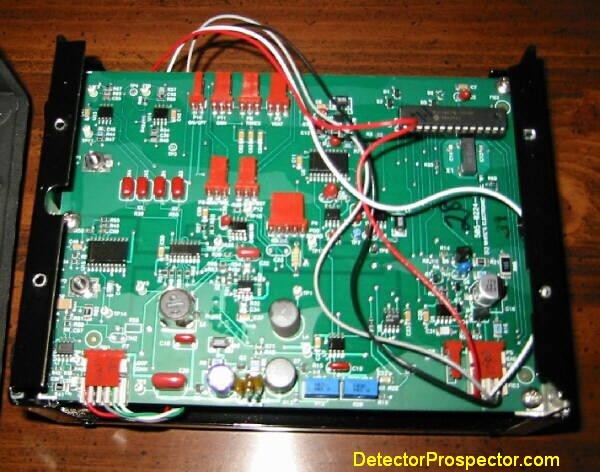
White's GMT Circuit Board -
Hi Mike,
So you ended up keeping it?
I have a GMT which is a great detector. It is too bad the SGT does not have a simple flip switch to go to a Locked mode. Like you say you can work around it but I prefer for the tracking to be shut off. It is very annoying on the tiniest gold targets which are exactly the targets I am normally looking for when I use the GMT.
Still, at $499 or less the Sierra Gold Trac is a certified smoking good deal in a hot 48 kHz ground tracking detector. It is far and away the lowest priced unit that offers ground tracking with the Tesoro Lobo at $799 being the next cheapest option. Too bad it is a semi-secret White's model only available to west coast dealers.
Maybe you can confirm something Mike. Jimmy's site indicates the SGT retains the GMT "Iron Grunt" feature but I believe this is a mistake on his website. The manual makes no mention of it. White's Sierra Gold Trac Owner's Manual Is the unit purely VCO all metal or is there an audio ferrous indication?
-
Thanks Mike. While this will tend to be prospecting oriented I do not intend on letting it be only that. I personally look for gold wherever I can find it. I jewelry hunt parks and tot lots. I love beach detecting. I still have not checked gold coin off my bucket list. Gold can be found almost anywhere, and there is no reason to limit looking for it to any particular means. So as a top-notch jewelry hunter I know you have things to contribute here.
-
I have contacted Garrett again and the information available has been refined.
"The ATX can be operated with Infinium DD coils. Performance with Infinium DD coils should be normal but is not guaranteed. The ATX cannot be operated with Infinium mono coils or any other Garrett coil other than ATX coils and Infinium DD coils. Recon Pro coils will not work on the ATX. The Recon Pro is not the same machine electronically, even though it looks similar. Use of any coil other than ATX coils and Infinium DD coils, including the use of 3rd party coils, will void the warranty."
So there you have it. The only coils you can run on the ATX are ATX coils (obviously) and Garrett Infinium DD coils. There are three Infinium DD coils available, 10" x 14" DD PN: 2217100, 5" x 10" DD PN: 2216700, and 3" x 7" DD PN: 2216600.
-
Hi Rob,
Great to see you here - thanks for joining!
As my review at http://www.detectorprospector.com/steves-mining-journal/gold-nugget-detecting-with-garrett-atx.htm the stock ATX coil does false when knocked or rolled on rocks, but not consistently. Enough though I tried to avoid hitting stuff with it. It never falsed once hitting bushes or stubble that I recall, but of course this was dry desert stuff. I do not think soft knocks will do it. My theory is it is sharper knocks causing cable motion. The coil is epoxy filled so should be impervious to falsing so I do not see what it could be but something farther up the line.
The ATX probably is a very good detector for New Zealand. There sure is a lot of the place that reminds me of Alaska. -
Hi Bob,
I was all over the place after the AMDS Forum folded but have not been happy since so decide to start a new home base here. Since I own this outright it will be around as long as I am, hopefully for a long time! Good to see you here, send any AMDS Forum orphans you see this way. Merry Christmas!


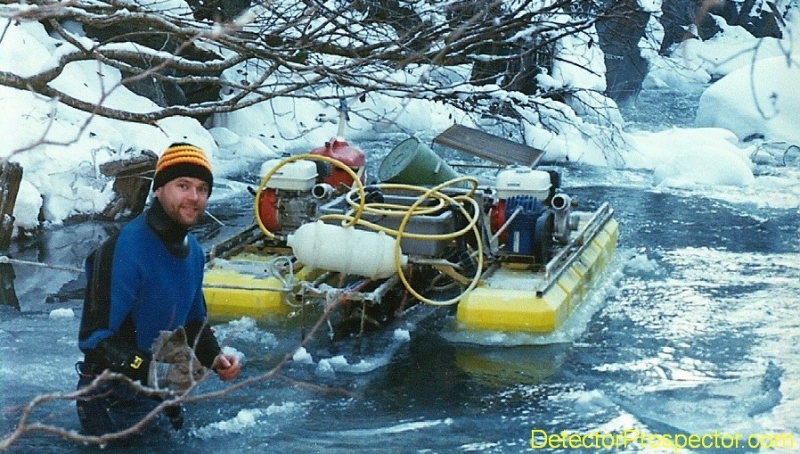
Congrats On The New Forum
in Detector Prospector Forum
Posted
Thank you JP! Another year older - "sigh".
Best wishes to all for a safe and prosperous New Year!